|
A REPORT OF THE 2ND WORLD ASSYRIAN CONFERENCE IN MOSCOW
courtesy of Zinda Magazine June 30/2003.
The Assyrians Today: Historiography & Linguistics
Friday, June 27, 2003
10.00 11.00 Opening Ceremony
11.00 13.00 Session I
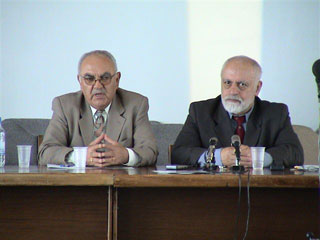
|
| Co-chairmen of the first session - Rabbi M. Mammoo & Prof. Mikhael Sado |
Co-chairmen: Rabbi M. Mammoo & Prof. Mikhael Sado
1. Dr. Sargis Osipov (Moscow, Russia): Modern Assyrians: Historical and Linguistic Sources of Diversities
2. Rabbi Michael
Mammoo (Stockholm, Sweden): The Importance of the Assyrian Language and the Difficulties Encountered in its Teaching
3.
Prof. Michael Sado (St. Petersburg, Russia): On some Aspects of Modern Literary Language of the Assyrians.
4. Mr. Hannibal
Gevargiz (Tehran, Iran): Assyrian Printing Presses in Iran
5. Ms. Naures Atoo (Leiden, Holland): Perceptions of Identity
among Suryoyo and Surai Academicians in the European Diaspora
6. Mr. Edward Badalov (Moscow, Russia): Assyrian Literature
in the Soviet Bibliography
13:00 14:00 Coffee Break
14.00 17.00 Session II
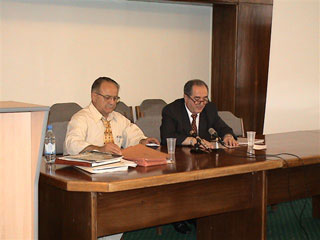
|
| Co-chairment of the second session - Dr. Norman Solhkhah & Dr. S.G. Osipov |
. Dr. Norman Solhkhah (Chicago, U.S.): Under Watch - Full Eyes of the Coalition Troops. 2. Mr. Aprim Shapera (London,
England): Fallcies in the Assyrian History. 3. Dr. Sargis Osopov (Moscow, RUSSIA): The Assyrian History - False Dogmas
and Majestic Truth. 4. Mr. Walter Veniaminov (Novorossiisk, Russia): Overall Description of Written Manuscripts on Legislation
of Ancient Mesopotamia. 5. Ms. Leena Yakubova (Erevan, Armenia): Assyrians and Armenians. A History of Relationship and
Interference in the Course of Centuries. 6. Dr. Daniel Sarkisov (Tbilisi, Georgia): The Role of Churches in the Assyrian
History Formation 7. Mr. Arsen SAVVA (Kazan, Russia): Development of the Assyrian Historiography during Political Evolution
in Russia (19th through 21st century). Saturday, June 28, 2003
10.00 13.00 Future of Iraq (The Round Table)
14.00 17.00 Meeting of the Assyrian Representatives from Commonwealth
of Independent States.
* * * * *
MODERN ASSYRIANS: HISTORICAL AND LINGUISTIC SOURCES OF DIVERSITIES
The 2nd World Assyrian Conference has completed its work in Moscow. Representatives from the Assyrian communities of Russia,
USA, Sweden, Holland, Armenia, Georgia reported at the conference. Also two reports sent to the Conference by Mr. Hannibal
Gevargiz (Iran) and Mr. Aprim Shapera (Great Britain) who could not attend the conference were read to the audience. The Proceedings
of the Conference will be published in the near future.
The questions raised at this conference may seem as merely having theoretical and academic significance, but they are of
great practical interest. Numerous problems, impossible to solve by means of political or social methods, face modern Assyrian
historiography and modern comprehension of Assyrian linguistics.
A dominant problem today is achieving unity. Without solving this problem all other goals and ideas are unattainable. To
preserve the nation, national origins, and to strive for the revival of our national heritage even in the form of autonomy
can be accomplished only by means of uniting all remaining fragments of once powerful nation.
We are confronted with unprecedented resistance concerning exactly the problem of uniting the nation and we see that no
arguments can lead to any consensus. Each fragment seeks its own way of self-identification and tries to convince the others
of its special solemnity, of its ethnic and confessional primordial status. Naturally a question arises: how to extirpate
this estrangement and convince everyone of the unity of their nature and in their community?
I believe that science has a priority in this issue, as only scientific method will give an opportunity to find the origins
of this estrangement and prove arguments in favor of the nations unity, the arguments based on objective historical data.
But again, its quite natural, that nobody but we will solve these problems.
We all know well enough how subjectively Assyrias history is interpreted and occasionally in diametrically different ways
depending on the interests of this or that historiography schools or even on tastes and wishes of this or that historian.
But the most important fact is that against this background national historiography is completely lacking, the point how the
Assyrian nation itself sees its history. Even if this vision be a subjective one. Out of all the books I know I can name only
one source a small book by Rabi Benjamin Arsanis The Fall of the Assyrian State, in which he manages to bring to the forefront
all those positive things that allow considering ancient Assyria the cradle of civilization.
If we can define these priorities and examine the whole path of the Assyrian nation after the fall of the Empire, especially
from the moment of adopting Christianity and appearance of ethno-confessional groups as a result of intra-church conflicts
aimed at the struggle for power, we will establish a firm basis in order to eliminate false discordant arguments and to unite
scattered fragments of the nation.
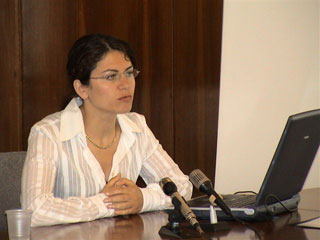
|
| Ms. Naures Atto from Leiden, Holland discussed perceptions of identity among academicians in Europe |
A similar situation has developed in the Assyrian linguistics. In addition to a natural division of the Aramaic language
into eastern and western branches, both these branches have many dialects. One cannot help considering the regularities, which
lead to the formation of a modern language. But again, our task is to define these regularities and find optimal ways for
forming a common literary language and perfection of the deep-rooted dialects. Will a literary language be formed only on
the basis of Classical Syriac, the so called lishana atiqa or only on the basis of a modern lishana svadaya? It is unlikely.
Most probably details of both languages will become the basis of it, as many classical roots have been lost once and for
all, and are not found in any of the modern dialects. And on the other hand, a number of neologisms in the modern language
have increased so much that its simply impossible to reject them basing only on the classical language.
Modern terminology is also necessary for correct correlation with principal languages of the modern world. It should be
considered in order to make translation from Assyrian and into Assyrian full-fledged to the maximum and proper in a semantic
sense.
Thus, reasoning from the above said, we considered that in todays situation which is extremely important for our nation,
solution of the issues concerning national historiography and linguistics could have great practical significance. If we solve
this problem we will have a real hope in changing the situation fundamentally.
But, first of all, we hoped for the concernment of our specialists in the sphere of history and language. Unfortunately
we havent received the expected interest and activity. It seems to me that most of them consider this work as a kind of a
hobby or as dilettantis game, which is of no interest for professionals. But the importance of this work for the future of
our nation is not taken into consideration. Alas, it is one more sign of assimilation and destruction of national consciousness.
The quicker we define priorities promoting national unification, the greater confidence in the future and hope for the
achievement of an unrealizable dream for the time being revival of our state - we will have.
Establishment of CANO-CIS
After completion of the conference a general meeting of the representatives from the Commonwealth of Independent States
(CIS) was held. The Confederation of the Assyrian National Organizations of CIS was established at this meeting. Associations
of the Assyrians from Armenia, Georgia, Kazakhstan, Ukraine and some regions of Russia Moscow, St. Petersburg, Tatarstan,
Krasnodar and Novorossyisk became members of the Confederation.
At the first meeting of the Confederation the following statement was drafted: the Confederation of the Assyrian National
Organizations of CIS manifests its full support of the Assyrian Democratic Movement (Zowaa) and its titanic efforts aimed
at the defense of the Assyrian nations interests in a new free Iraq. The Confederation calls upon the entire Assyrian nation
to support Zowaas efforts in every way and express solidarity with it. The Confederation considers it necessary to declare
that the compromises to which Zowaa agreed are necessary and well-taken at the modern stage. The Confederation representing
the interests of the Assyrian nation of CIS considers its supreme and vital task to be of support to our brothers in Iraq
in order to achieve the main national goal establishing Assyrian Autonomy in a new federative Iraq.
Igor Kolomiets
Russia
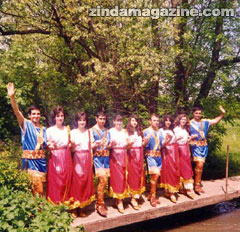
URMIA: AN ASSYRIAN VILLAGE IN RUSSIA
The word Ur means cradle or city and mia is water in Assyrian. Urmia is therefore a city or dwelling by the waters. This
is also the name of a picturesque lake in the north-west of Iran, inhabitted by Assyrians since the first millienum B.C. The
city of Urmia (or Oroomiyeh) is located on the eastern side of Lake Urmia.
The first settlement of Assyrians in Russia occured around 1830 in Transcaucasia, on the territory of the modern Armenia
after Russo-Persian war which led to Turkmanchai Peace Agreement. The Assyrian Christians began to arrive in Russia in the
hope of finding protection from the Muslims. A few Assyrian villages were established in Armenia not far from Yerevan. These
are Koylasar (Qalla dAssour) nowadays called Dimitrovo, also Dvin, Arzni, Shagriyar, Gill. Gill was located in the mountains
and has disappeared since. Between 1870 and 1875 in Koylasar, the first Assyrian school was established in Russia. It was
founded by a great Assyrian scholar and teacher, Rabbie Pavel Aivazov.
In 1877-78 the Russo-Turkish war brought a new wave of Assyrian refugees to Russia and another Assyrian village appeared
on the shores of the river Aras (Araxes). The river served as a border between Russia and Turkey. The village of KarkhanArazdayans
inhabitants were mainly the natives of the village of Atlakandy in the Urmia plains in Iran.
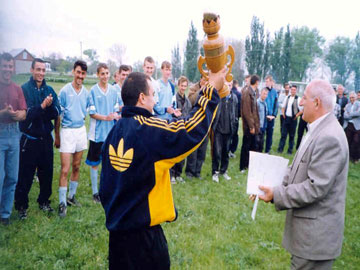
|
| Mr. Oleg Georgizov hands the First Place Cup to the captain of the Urmia Soccer team |
The focus of this article are the Assyrians of Kuban region, in southern Russia. The appearance of Assyrians in Russia
was not a random event. At the beginning of the 20th century the Russian troops were positioned in northern Persia. The main
part of the Russian troops consisted of the Cossack regiment of the Labink district. Labinsk is a small town in the Kuban.
region. The relationship between the Assyrians and Labinsk soldiers was harmonious, a factor which later compelled Assyrian
to seek refuge in Labinsk. On arriving in Labinsk Assyrians started farming.
The local authorities of the Soviet regime were concerned about the constant flow of Assyrian refugees and were trying
to find a shelter for them. At the same time Russia was going through a period of dispossession of the kulaks (land-owners)
and collectivization, the result of which was the the freeing of the land under kulaks. The authorities decided to give the
Assyrian refugees the pieces of land that were hardly used not far from Novoalekseevskaya village of Kurganinskiy district.
Thus, the first Assyrian village was born in the Kuban region in 1924. The natives of Atlakandy called it Urmia.
In 1925 the World Convention of Assyrians took place in Moscow. It was organized by the All-Union Society of Assyrians
Khayadta headed by S. Piraev. Khaydtas mission was to unite Assyrians of Russia. It undertook numerous attempts to maintain
the Assyrian language, folklore, dances, and maintaining Assyrian culture. It was all possible as long as the Assyrians lived
together and not in isolation. Thus, they turned to Urmia. Khaydta began to persuade Assyrians to move to Urmia, where they
could plan a cultural center for the Assyrians. Many Assyrians moved to Urmia from a great number of places in Russia. A growing
village, it numbered around 50-70 families.
In 1926 in Armavir (30 kilometers from Urmia) Rabbie Enwiya Georgizov and Rabbie Ushanna Bedroyev established an Assyrian
school. In the beginning they taught four classes. However the school quickly grew and by 1929 it had 7 classes. Many young
Assyrians from all over the Soviet Union moved to Urmia having heard about this institution of learning. A hundred Assyrians
moved from Armenia. Local authorities offered two buildings for this school: one for holding the classes and another as a
dormitory. The government funded the school for meals and other needs.
In 1932 the Armavir State College introduced a special course for those who successfully completed 7-years education in
the Assyrian school. The same year Rabbie Enwiya Georgizov moved to the village of Urmia to organize a new 4-year school.
He was subsequently the headmaster of the School in Urmia, a career which spanned 30 years. Every year he sent 25-30 students
to the Assyrian school in Armavir.
Being in an unfamiliar environment Assyrians had to maintain their language, culture, traditions. Life of Rabbie
Enwiya Georgizov was devoted to the school in Urmia; he was one of the most educated people of his time in Russia. Besides
history and other subjects he taught Assyrian language. He also translated plays by worlds renowned playwrights into Assyrian
and directed the drama class. But the most precious investment that was ever made by Rabbie Georgizov was keeping Assyrian
language alive through his book The Grammar of Assyrian Language. At the same time he organized the Assyrian dance group which
is still active. Urmia still exists and remains the densest location of existence for the Assyrians in Russia.
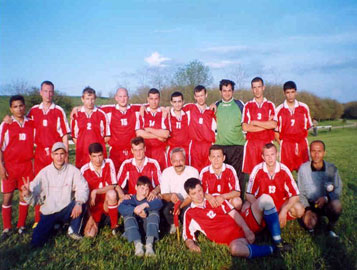
|
| The Krasnodar Soccer Team at the Urmia Soccer Tournament |
Krasnodar is the the capital of Kuban (170 km from Urmia). Krasnodar Assyrians had always wishes to maintain their language,
culture and traditions. Nevertheless, this goal became possible only after the collapse of the Soviet Union.
In 1990 The
Assyrian Society of Kuban or Khaydta was established and registered by Mr. Oleg Georgizov (a son of Rabbie Enwiya Georgizov).
This was the beginning of very active social life for Assyrians.
Assyrians from Krasnodar organized several community groups around Russia which included dance groups, soccer teams, language
and history classes. 1990s were marked with an impetuous rise of national identity among Assyrians, especially in the Kuban
region. One of the events that has become a tradition since 1991 is the Assyrian soccer tournament which takes place every
year in Urmia. The soccer teams from St.Petersburg, Moscow, Krasnodar, Labinsk, Urmia and the Republics of Armenia and Georgia
take part in these tournaments. Unfortunately due to recent political and economical changes, the teams from Armenia and Georgia
have not been able to participate since 1994. The tournaments take place between the first and fifth of May, when a few thousand
Assyrians from all over Russia participate in the festivities and come to Urmia. The games take place during the day, and
in the evening all Assyrians come together in the local social club and dance until the dawn. Urmia does not have hotels or
motels, but the doors of every house in this village are open for any guest that arrives.
The Assyrian dance group Nineveh in Krasnodar was established in 1993 under the Center for the National Cultures. The Assyrian
youth of Krasnodar had a yearning for learning their culture, dances and language. Young people from Krasnodar, and the villages
of Dinskaya, Afipslkaya, and Krymsk are members of this group. Everybody wished to learn Assyrian dances, resurrect the ancient
Assyrian dance forms and also show Assyrian culture to people of different nationalities in Kuban. They realized that keeping
our culture alive depended on them alone.
Nineveh still exists. It takes part in different concerts and meetings that are carried out by Krasnodar authorities for
different nationalities. The Russian representatives and people of other nationalities welcome and enjoy the demonstrations
of our dance group.
Alla Georgizova
Krasnodar, Russia
[Z-info: Translated from Russian by Ms. Nina Georgizova].
courtesy of Zinda magazine June 2 / 2003
|
